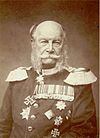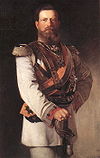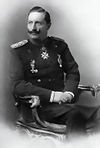- List of German monarchs
-
This article lists the monarchs of Germany, those who ruled over the German-speaking territories of central Europe from the creation of a separate Eastern Frankish Kingdom in 843 until the end of German Empire in 1918. It also includes the heads of the various German confederations after the collapse of the Holy Roman Empire in 1806.
The relationship between the title of "king" and "emperor" in the area that is today called Germany is just as complicated as the history and the structure of the Holy Roman Empire itself. The Kingdom of Germany predates the Empire.
- The Kingdom of Germany started out as the eastern section of the Frankish kingdom, which was split by the Treaty of Verdun in 843. The rulers of the eastern area thus called themselves rex Francorum, king of the Franks, and later just rex. A reference to the "Germans", indicating the emergence of a German nation of some sort, did not appear until the eleventh century, when the Pope referred to his enemy Henry IV as rex teutonicorum, King of the Teutons, in order to brand him as a foreigner. The kings reacted by consistently using the title rex Romanorum, King of the Romans, to emphasize their universal rule even before becoming Emperor. This title remained until the end of the Empire in 1806.
- The Kingdom of Germany was never entirely hereditary; rather, ancestry was only one of the factors that determined the succession of kings. The king was formally elected by the leading nobility in the realm, continuing the Frankish tradition. Gradually the election became the privilege of a group of princes called Electors and the Golden Bull of 1356 formally defined election proceedings.
- In the Middle Ages, the King did not assume the title "Emperor" (since 982 the full title had been Imperator Augustus Romanorum, Venerable Emperor of the Romans) until crowned by the Pope. He first had to be crowned with the Iron Crown of Lombardy, after which he assumed the title of rex Italiae, King of Italy. After this he would ride on to Rome and be crowned Emperor by the Pope.
- Maximilian I was the first King to bear the title of Emperor-Elect. After the failure in 1508 of his attempt to march to Rome and to be crowned by the Pope, he had himself proclaimed Emperor-elect with papal consent. His successor Charles V also assumed that title after his coronation in 1520 until he was crowned Emperor by the Pope in 1530. From Ferdinand I onwards, all Emperors were merely Emperors-Elect, although they were normally referred to as Emperors. At the same time, chosen successors of the Emperors were called King of the Romans, if elected by the college of Electors during their predecessor's lifetime.
Contents
Eastern Frankish Kingdom, Holy Roman Empire 843-1806
This section covers the Eastern Frankish Kingdom, the eastern portion of the Frankish Empire after its partition by the Treaty of Verdun in 843. Later it became known as the Kingdom of Germany, which was the chief (and then sole) component of the Holy Roman Empire (of the German Nation)[citation needed].
The German Kingdom comprised not only the territory of modern Germany, but also that of Austria, Switzerland, the Czech Republic, Slovenia, and the Low Countries, as well as parts of modern France, Italy and Poland.
Kings
Emperors are listed in bold. Rival kings, anti-kings, and junior co-regents are italicized.
Name House King Emperor Ended Notes Louis the German
(Ludwig II der Deutsche)Carolingian 11 August 843 — 23 August 876 Son of Emperor Louis the Pious and grandson of Charlemagne Louis the Younger
(Ludwig III der Jüngere)Carolingian 28 August 876 — 20 January 882 Son of Louis the German; ruled in East Francia, Saxony, from 880 also Bavaria Carloman
(Karlmann)Carolingian 28 August 876 — 22 March 880 Son of Louis the German; ruled in Bavaria; from 877 also King of Italy Charles the Fat
(Karl III, der Dicke)Carolingian 28 August 876 12 February 881 11 November 887 Son of Louis the German; ruled in Alemannia, Raetia, from 882 in the entire Eastern Kingdom; from 879 also King of Italy Arnulf of Carinthia
(Arnulf von Kärnten)Carolingian 30 November 887 25 April 896 8 December 899 Son of Carloman Louis the Child
(Ludwig IV das Kind)Carolingian 21 January 900 — 20/24 September 911 Son of Arnulf of Carinthia Conrad I
(Konrad I)Conradine (Franconian) 10 November 911 — 23 December 918 Henry I the Fowler
(Heinrich I der Vogler)Liudolfing 23 April 919 — 2 July 936 Arnulf the Bad
(Arnulf der Böse, Herzog von Bayern)Luitpolding (Bavarian) 919 — 921 Rival king to Henry I Otto I the Great
(Otto I der Große)Ottonian 7 August 936 2 February 962 7 May 973 Son of Henry I; first king crowned in Aachen Cathedral since Lothair I;crowned as Otto by the grace of God King[1]; crowned Holy Roman Emperor in 961. Otto II the Red
(Otto II)Ottonian 26 May 961 25 December 967 7 December 983 Son of Otto I;
Otto by the grace of God King[1] under his father 961–973;
also crowned Emperor in his father's lifetimeOtto III
(Otto III)Ottonian 25 December 983 21 May 996 21 January 1002 Son of Otto II; Otto by the grace of God King[1] Henry II
(Heinrich II der Heilige)Ottonian 7 June 1002 26 April 1014 13 July 1024 Great-grandson of Henry I Conrad II
(Konrad II)Salian (Frankish) 8 September 1024 26 March 1027 4 June 1039 Great-great-grandson of Otto I Henry III
(Heinrich III)Salian 14 April 1028 25 December 1046 5 October 1056 Son of Conrad II;
King (of the Germans?)[1] under his father 1028–1039Henry IV
(Heinrich IV)Salian 17 July 1054 21 March 1084 31 December 1105 Son of Henry III;
King of Germany under his father 1054–1056Rudolf von Rheinfeld
(Rudolf von Rheinfelden)Rheinfeld 15 March 1077 — 15 October 1080 Rival King to Henry IV Hermann von Salm
(Hermann von Luxemburg, Graf von Salm)Salm 6 August 1081 — 28 September 1088 Rival King to Henry IV Conrad
(Konrad)Salian 30 May 1087 — 27 July 1101 Son of Henry IV;
King of Germany under his father 1087–1098,
King of Italy 1093–1098, 1095–1101 in rebellion.Henry V
(Heinrich V)Salian 6 January 1099 13 April 1111 23 May 1125 Son of Henry IV;
King of Germany under his father 1099–1105, forced his father to abdicate.Lothair III
(Lothar III)Supplinburger 30 August 1125 4 June 1133 4 December 1137 Conrad III
(Conrad III)Hohenstaufen 7 March 1138 — 15 February 1152 Grandson of Henry IV (through his mother);
Previously Rival King to Lothair III 1127–1135Henry Berengar
(Heinrich (VI))Hohenstaufen 30 March 1147 — August? 1150 Son of Conrad III;
King of Germany under his father 1147–1150Frederick I Barbarossa
(Friedrich I Barbarossa)Hohenstaufen 4 March 1152 18 June 1155 10 June 1190 Nephew of Conrad III Henry VI
(Heinrich VI)Hohenstaufen 15 August 1169 14 April 1191 28 September 1197 Son of Frederick I;
King of Germany under his father 1169–1190Frederick II
(Friedrich II)Hohenstaufen 1197 — 1197 Son of Henry VI;
King of Germany under his father 1196Philip of Swabia
(Philipp von Schwaben)Hohenstaufen 6 March 1198 — 21 August 1208 Son of Frederick I; Rival king to Otto IV Otto IV
(Otto IV von Braunschweig)Welf 29 March 1198 4 October 1209 5 July 1215 Rival king to Philip of Swabia; later opposed by Frederick II; deposed 1215; died 19 May 1218 Frederick II
(Friedrich II)Hohenstaufen 5 December 1212 22 November 1220 26 December 1250 Son of Henry VI;
Rival king to Otto IV until 5 July 1215Henry
(Heinrich (VII))Hohenstaufen 23 April 1220 — 15 August 1235 Son of Frederick II;
King of Germany under his father 1220–1235Conrad IV
(Konrad IV)Hohenstaufen May 1237 — 1 May 1254 Son of Frederick II;
King of Germany under his father 1237–1250Henry Raspe
(Heinrich Raspe)Thuringia 22 May 1246 — 16 February 1247 Rival King to Frederick II William of Holland
(Wilhelm von Holland)Holland 3 October 1247 — 28 January 1256 Rival King to Frederick II and Conrad IV, 1247–1254 Richard of Cornwall
(Richard von Cornwall)Plantagenet 13 January 1257 — 2 April 1272 Rival king to Alfonso of Castile; held no real authority. Alfonso of Castile
(Alfons von Kastilien)House of Burgundy 1 April 1257 — 1275 Grandson of Philip; Rival king to Richard of Cornwall; held no authority; later opposed by Rudolf I; relinquished claims 1275, died 1284 Rudolf I
(Rudolf I von Habsburg)Habsburg 29 September 1273 — 15 July 1291 Adolf of Nassau
(Adolf von Nassau)Nassau 5 May 1292 — 23 June 1298 According to some historians, Adolf's election was preceded by the short-lived kingship of Conrad, Duke of Teck. See his article for details. Albert I
(Albrecht I von Habsburg)Habsburg 24 June 1298 — 1 May 1308 Son of Rudolf I; Rival King to Adolf of Nassau, 1298 Henry VII
(Heinrich VII, Luxemburger)Luxembourg 27 November 1308 13 June 1311 24 August 1313 Louis IV
(Ludwig IV, der Bayer, Wittelsbacher)Wittelsbach 20 October 1314 17 January 1328 11 October 1347 Grandson of Rudolf I; Rival king to Frederick the Fair 1314–1322 Frederick the Fair
(Friedrich der Schöne, Habsburger)Habsburg 19 October 1314/
5 September 1325— 28 September 1322/
13 January 1330Son of Albert I;
Rival king to Louis IV 1314–1322;
associate king with Louis IV 1325–1330Charles IV
(Karl IV von Luxemburg)Luxembourg 11 July 1346 5 April 1355 29 November 1378 Grandson of Henry VII; Rival king to Louis IV, 1346–1347 Günther von Schwarzburg
(Günther von Schwarzburg)Schwarzburg 30 January 1349 — 24 May 1349 Rival King to Charles IV Wenceslaus
(Wenzel von Luxemburg)Luxembourg 10 June 1376 — 20 August 1400 Son of Charles IV; King of Germany under his father 1376–1378; deposed 1400; died 1419 Rupert of Palatinate
(Ruprecht von der Pfalz, Wittelsbacher)Wittelsbach 21 August 1400 — 18 May 1410 Great-grandnephew of Louis IV Sigismund
(Sigismund von Luxemburg)Luxembourg 20 September 1410/
21 July 14113 May 1433 9 December 1437 Son of Charles IV Jobst of Moravia
(Jobst von Mähren, Luxemburger)Luxembourg 1 October 1410 — 8 January 1411 Nephew of Charles IV; Rival King to Sigismund Albert II
(Albrecht II)Habsburg 18 March 1438 — 27 October 1439 4th in descent from Albert I;
son-in-law of SigismundFrederick III
(Friedrich III)Habsburg 2 February 1440 16 March 1452 19 August 1493 4th in descent from Albert I; 2nd cousin of Albert II Maximilian I
(Maximilian I)Habsburg 16 February 1486 4 February 1508
Emperor-elect12 January 1519 Son of Frederick III; King of Germany under his father 1486–1493; adopted the title Emperor-elect in 1508 with the Pope's approval Charles V
(Karl V)Habsburg 28 June 1519 24 February 1530 3 August 1556 Grandson of Maximilian I; died 21 September 1558 Ferdinand I
(Ferdinand I)Habsburg 5 January 1531 14 March 1558
Emperor-elect25 July 1564 Grandson of Maximilian I; brother of Charles V; King of Germany under his brother Charles V 1531–1556; last king to be crowned in Aachen Cathedral. Maximilian II
(Maximilian II)Habsburg 22 November 1562 25 July 1564
Emperor-elect12 October 1576 Son of Ferdinand I;
King of Germany under his father 1562–1564Rudolf II
(Rudolf II)Habsburg 27 October 1575 2 November 1576
Emperor-elect20 January 1612 Son of Maximilian II;
King of Germany under his father, 1575–1576Matthias
(Matthias)Habsburg 13 June 1612 13 June 1612
Emperor-elect20 March 1619 Son of Maximilian II Ferdinand II
(Ferdinand II)Habsburg 28 August 1619 28 August 1619
Emperor-elect15 February 1637 Grandson of Ferdinand I Ferdinand III
(Ferdinand III)Habsburg 22 December 1636 15 February 1637
Emperor-elect2 April 1657 Son of Ferdinand II;
King of Germany under his father 1636–1637Ferdinand IV
(Ferdinand IV)Habsburg 31 May 1653 — 9 July 1654 Son of Ferdinand III;
King of Germany under his fatherLeopold I
(Leopold I)Habsburg 18 July 1658 18 July 1658
Emperor-elect5 May 1705 Son of Ferdinand III Joseph I
(Joseph I)Habsburg 23 January 1690 5 May 1705
Emperor-elect17 April 1711 Son of Leopold I; King of Germany under his father 1690–1705 Charles VI
(Karl VI)Habsburg 27 October 1711 27 October 1711
Emperor-elect20 October 1740 Son of Leopold I Charles VII
(Karl VII)Wittelsbach 14 January 1742 14 January 1742
Emperor-elect20 January 1745 Husband of Maria Amalia, daughter of Joseph I Francis I
(Franz I)Lorraine 13 September 1745 13 September 1745
Emperor-elect18 August 1765 Husband of Maria Theresa, daughter of Charles VI Joseph II
(Joseph II)Habsburg-Lorraine 27 March 1764 18 August 1765
Emperor-elect20 February 1790 Son of Francis I and Maria Theresa; King of Germany under his father 1764–1765 Leopold II
(Leopold II)Habsburg-Lorraine 30 September 1790 30 September 1790
Emperor-elect1 March 1792 Son of Francis I and Maria Theresa Francis II
(Franz II)Habsburg-Lorraine 7 July 1792 7 July 1792
Emperor-elect6 August 1806 Son of Leopold II; Dissolved the Holy Roman Empire; also Emperor of Austria 1804–1835; died 1835 Imperial vicars
Main article: Imperial vicarDuring interregna, imperial authority was exercised by two imperial vicars — the Elector of Saxony, in his role as Count Palatine of Saxony, exercised this office in northern Germany, and the Elector Palatine, as Count Palatine of the Rhine, exercised it in southern Germany. The confusion over the Palatine electorate during the Thirty Years War and afterwards led to some confusion about who the rightful vicar was in the later years of the Empire.
German confederations, 1806-1871
Confederation of the Rhine, 1806-1813
Name Title House Began Ended Napoleon I,
Emperor of the French
(Napoléon I, Kaiser der Franzosen)Protector of the
Confederation of the RhineBonaparte 25 July 1806 19 October 1813 German Confederation, 1815-1866
Name Title House Began Ended Francis I,
Emperor of Austria
(Franz I, Kaiser von Österreich)President of the
German ConfederationHabsburg-Lorraine 20 June 1815 2 March 1835 Ferdinand I,
Emperor of Austria
(Ferdinand I, Kaiser von Österreich)President of the
German ConfederationHabsburg-Lorraine 2 March 1835 12 July 1848 Archduke Johann of Austria Imperial Vicar[2] Habsburg-Lorraine 12 July 1848 20 December 1849 Frederick William IV, King of Prussia
(Friedrich Wilhelm IV, König von Preußen)Emperor of the Germans elect Hohenzollern elected Emperor of the Germans by the Frankfurt Assembly on 28 March 1849, but refused the crown on 3 April 1849 Frederick William IV, King of Prussia
(Friedrich Wilhelm IV, König von Preußen)President of the
German UnionHohenzollern 26 May 1849 29 November 1850 Francis Joseph I,
Emperor of Austria
(Franz Joseph I, Kaiser von Österreich)President of the
German ConfederationHabsburg-Lorraine 1 May 1850 24 August 1866 North German Confederation, 1867-1871
Name Title House Began Ended Wilhelm I,
King of Prussia
(Wilhelm I, König von Preußen)President of the
North German ConfederationHohenzollern 1 July 1867 18 January 1871[3] German Empire, 1871–1918
Image Name Date of birth Monarch From Monarch Until Date of death Son of Frederick William III William I
(Wilhelm I)
(Hohenzollern)22 March 1797 18 January 1871 9 March 1888 Son of Wilhelm I Frederick III
(Friedrich III)
(Hohenzollern)18 October 1831 9 March 1888 15 June 1888 Son of Frederick III Wilhelm II
(Hohenzollern)27 January 1859 15 June 1888 9 November 1918 4 June 1941 Family tree
The relationships are shown at Kings of Germany family tree.
Footnotes
- ^ a b c d Medieval Europeans: studies in ethnic identity and national perspectives in medieval Europe By Alfred P. Smyth, Palgrave Macmillan (1998), p. 64
- ^ elected by the Frankfurt National Assembly as Imperial Vicar of a new German Reich. The German Confederation was considered dissolved.
- ^ He was proclaimed German Emperor on that day.
External links
Monarchs of Germany Eastern Francia (843–918) 
Saxon Kingdom (919–62) Kingdom of Germany
in the Holy Roman Empire
(962–1806)- Otto I
- Otto II
- Otto III
- Henry II
- Conrad II
- Henry III
- Henry IV
- Henry V
- Lothair III
- Conrad III
- Frederick I
- Henry VI
- Philip
- Otto IV
- Frederick II
- Conrad IV
- Rudolf I
- Adolf
- Albert I
- Henry VII
- Louis IV
- Charles IV
- Wenceslaus
- Rupert
- Sigismund
- Albert II
- Frederick III
- Maximilian I
- Charles V
- Ferdinand I
- Maximilian II
- Rudolph II
- Matthias
- Ferdinand II
- Ferdinand III
- Leopold I
- Joseph I
- Charles VI
- Charles VII
- Francis I
- Joseph II
- Leopold II
- Francis II
Confederation of the Rhine (1806–1813) - Napoleon I
German Confederation (1815–1848) German Empire (1849) - Frederick William IV (emperor-elect)
German Confederation (1850–1866) North German Confederation (1867–1871) German Empire (1871–1918) Categories:- Lists of monarchs
- German kings
- Lists of political office-holders in Germany
Wikimedia Foundation. 2010.



